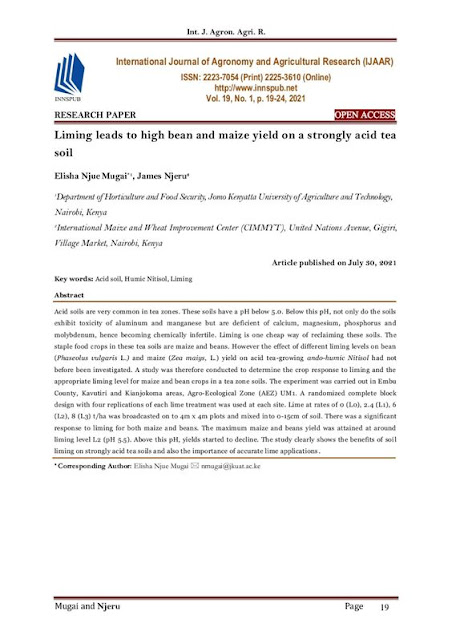Mr. Elisha Njue Mugai, and James Njer from the institute of the Department of Horticulture and Food Security, Jomo Kenyatta University of Agriculture and Technology, Nairobi, Kenya, and International Maize and Wheat Improvement Center (CIMMYT), United Nations Avenue, Gigiri, Village Market, Nairobi, Kenya wrote a research paper entitled "Liming leads to high bean and maize yield on a strongly acid tea soil" published by the International Journal of Agronomy and Agricultural Research | IJAAR, an affiliated journal of the International Network For Natural Sciences | INNSPUB, an open access scholarly research journal publishing company.
Abstract
Acid soils are very common in tea zones. These soils have a pH below 5.0. Below this pH, not only do the soils exhibit toxicity of aluminum and manganese but are deficient of calcium, magnesium, phosphorus and molybdenum, hence becoming chemically infertile. Liming is one cheap way of reclaiming these soils. The staple food crops in these tea soils are maize and beans. However the effect of different liming levels on bean (Phaseolus vulgaris L.) and maize (Zea maiys, L.) yield on acid tea-growing ando-humic Nitisol had not before been investigated. A study was therefore conducted to determine the crop response to liming and the appropriate liming level for maize and bean crops in a tea zone soils. The experiment was carried out in Embu County, Kavutiri and Kianjokoma areas, Agro-Ecological Zone (AEZ) UM1. A randomized complete block design with four replications of each lime treatment was used at each site. Lime at rates of 0 (L0), 2.4 (L1), 6 (L2), 8 (L3) t/ha was broadcasted on to 4m x 4m plots and mixed into 0-15cm of soil. There was a significant response to liming for both maize and beans. The maximum maize and beans yield was attained at around liming level L2 (pH 5.5). Above this pH, yields started to decline. The study clearly shows the benefits of soil liming on strongly acid tea soils and also the importance of accurate lime applications.
Introduction
Strongly acid soils are very common in tea zones
(Njeru et al., 2012). Soil is termed acidic when its pH
goes below 5.5 (Sombroek, et al.,1984) . Below this
pH value, the soil not only exhibits toxicity of
aluminium (Al) and manganese (Mn) but also is likely
to suffer deficiency of calcium (Ca), magnesium (Mg),
phosphorus (P) and molybdenum (Mo), hence
becoming infertile chemically (Von Uexküll and
Mutert, 1995). Bean yield has been shown to reduce
significantly as a result of this infertility (mugai et al.,
2008). The application of high-input soil management
technologies like expensive mineral fertilizers to
increase food crop yields may not be feasible due to the
low income levels of the farmers. Therefore the best
approach should be a moderate input technology, like
soil liming, which does not attempt to eliminate the use
of fertilizers but rather complements them and
maximizes their efficiency. Appropriate liming of acid
soils eliminates Al toxicity, leads to supply of Ca
andmg, and mobilises the fixed soil P and Mo (Njeru
et al., 2012; Mugai, 2008). This leads to increased
yields without even application of expensive mineral
fertilizers or with low applications of phosphorus (P)
and nitrogen (N) (Quaggio et al., 1995).
On the other hand the effect of different liming levels
on bean and maize yield on acid tea growing soil had
not been investigated. It was therefore not possible to
authoritatively recommend the lime level that could
be applied in beans and maize crop in tea zones. The
study was therefore conducted to determine the
response and the appropriate liming level for maize
and bean crops in a strongly acid tea zone soil. Check out more by following the link Liming leads to high bean and maize yield on a strongly acid tea soil
Reference
Chapman HD, Pratt PF. 1961. Methods of analysis for soils, plants and waters. University of California, Los Angeles 60-61, 150-179.
FAO-Unesco. 1988. Soil map of the world. Revised legend, by FAO–UNESCO–ISRIC. World Soil Resources Report No. 60. Rome.
Hinga FN, Muchena, Njihiacm FN. 1980. Physical and Chemical Methods of Soil Analysis. National Agricultural Laboratories, MoA, Kenya.
Kenya Soil Survey (KSS). 2007. Soil Science Society of East Africa Excursion Route Guide, Embu, Kenya.
Mitchell CC. 1999. Soil Acidity and Liming (Overview), Department Crop and Soil Environmental Science,Clemson University. Available online at: http://hubcap.clemson.edu/~blpprt/pdf
Mugai EN, Agong SG, Matsumoto H. 2008. The effect of liming an acid nitisol with either calcite or dolomite on two common bean (Phaseolus vulgaris L.) varieties differing in aluminium tolerance. Journal of Agriculture Science and technology, 10(2), 9-34.
Njeru MJ, Mugai EN, Njoroge G, Nyende AB. 2012. The impact of liming on biodiversity in Embu tea zone landscapes: A case study of Kavutiri area. Afr. J. Hort. Sci 6, 61-71.
Quaggio JA, Teófilo Sobrinho J, Dechen AR. 1992. Response to liming of ‘Valencia’ orange tree on Rangpur lime: effects of soil acidity and plant growth and yield. Proceedings of the International Society of Citriculture 2, 623-632.
Soil Survey Staff – USDA. 1999. Soil taxonomy: A basic system of soil classification for making and interpreting soil surveys. 2nd edition. Natural Resources Conservation Service. U.S. Department of Agriculture Handbook 436.
Sombroek WG, Braun HMH, Van der Pouw BJA. 1984. Exploratory Soil Map and Agro-climatic Zone Map of Kenya. Kenya Soil Survey. MoA, Kenya.
Tessens E, Shamshuddin J. 1982. Characteristics related to charges in oxisols of peninsular Malaysia. Pedologie XXXII (1), 85-106.
Von Uexkull, HR, Mutert E. 1995. Global extent, development and economic impact of acid soils. Plant and Soil 171, 1-15.
Warren GP, Kihanda FM. 2001. Nitrate leaching and adsorption in a Kenyan Nitisol. Soil Use and Management 17, 222-228.
%20and%20with%20liming%20at%20L2%20(pH%205.5)%20at%20Kavutiri%20site..png)















0 comments:
Post a Comment